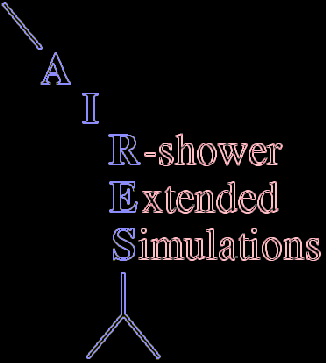 |
AIRES release notes. |
These notes briefly summarize the new developments and/or
improvements of the current version of AIRES. For more detailed
information on any of these new features, refer to the user's manual
and/or the demo files that come with the corresponding AIRES
distribution.
Release notes for AIRES 19.04.10.
Output data and analysis tools
-
Python interface. All the modules that make the AIRES shared
object library can now be called from a Python environment in s
simple way. This feature of AIRES makes it possible, among other
applications, to analyse output from AIRES simulations (even old
output files created with AIRES versions prior to 19.04.10) by means
of Python scripts/programs, therefore allowing Python programmers to
take advantage simultaneously of a clear and powerful
object-oriented programming language like Python, and the speed and
stability of AIRES library routines that can fastly scan compressed
output files with millions of particle entries. For details read the
file AIRES-Python-README.txt included in the AIRES
distribution (see inside the doc directory).
Bugs
-
Some minor technical bugs with no appreciable effects on the physical
algorithms have been fixed.
Release notes for AIRES 19.04.08.
Bugs
-
Correction of a bug related with the interface of AIRES with the
hadronic collision packages EPOS and SIBYLL (many thanks to Jaime
Alvarez-Muñiz, Henk Brans, Roberta Colalillo, Eva Santos, and
Matías Tueros).
Release notes for AIRES 19.04.06.
Algorithm modifications
- Hadronic collision external packages.
- This new release of AIRES includes the newest versions of
EPOS and SIBYLL.
Bugs
-
Several problems with AIRES 19.04.00 simulation program were detected
or reported by several users. All the errors in the program's
code -mostly minor bugs- were fixed and are no longer present in the
current version of AIRES. Some of those bugs are:
- Correction of a checkpoint/restart bug related with function
grandom (bug found thanks to M. Tueros). Now the
status of grandom is also saved into the idf file.
- Correction of a bug related with error message initialization in
some auxiliary programs (thanks to an indication by M. Tueros).
Release notes for AIRES 19.04.00.
Algorithm modifications
- Atmosphere.
- All the code related with the atmospheric model
management has been carefully reviewed. New atmospheric profile
models, namely SouthPoleAvg and MalargueAvg, are now
available (see directive Atmosphere), corresponding to
annual averages of atmospheric profiles of the South Pole and
Malargue sites, respectively. Additionally, the new directive
AddAtmosModel allows the user to define custom atmospheric
models that can be used alternatively to the built-in models.
- Neutrinos.
- New tables available (6296, 6496, and 6796) that
record the number and energy of created secondary neutrinos as a
function of atmospheric depth.
- Dynamic setting of primary energy.
- The special primary
modules are now capable of setting
the shower primary energy dynamically at the moment they are invoked
to inject the special primary particles (the PrimaryEnergy
IDL directive is no more mandatory in such cases).
Installation procedure
- The installation procedure now supports the installation of
extensions to the AIRES programs.
-
A series of utility programs and special
particle modules are automatically build during the
installation procedure, for example:
-
acfreccount. Utility to count the number of
records of a given AIRES compressed file (.grdpcles or .lgtpcles).
- acfscan. Scans a given AIRES compressed file and
returns information about the data it contains.
- airescode2pname, pname2airescode. AIRES
code from particle name, and vice-versa (e.g.,
"pname2airescode pi+" returns "11"; "airescode2pname 11"
returns "pi+").
- mergeciofiles. Combine the data contained within
various AIRES compressed files onto a single file.
- specialprim0. The special particle module used in
the "specialprimdemo" (basic special particle demo).
- multiprims. The special particle module used in
the multiprimary shower demos, that allow to
easily simulate showers with many primary particles.
Input Directive Language
- New features.
-
The site TelescArray was included to the default site
library, and can be selected by means of the Site
directive.
-
New built-in atmospheric models SouthPoleAvg and
MalargueAvg are available. They
can be selected using the Atmosphere directive.
- New directives.
- Directives that changed their
syntax or behavior.
- AddSpecialParticle.
- Atmosphere.
- Input.
- InputPath.
- Shell.
Output data
- New output tables.
- The current AIRES version includes 4
new tables:
-
0100. Atmospheric profile.
-
6296. Number of created particles: All neutrinos.
-
6496. Number of created entries: All neutrinos.
-
6796. Energy of created particles: All neutrinos.

